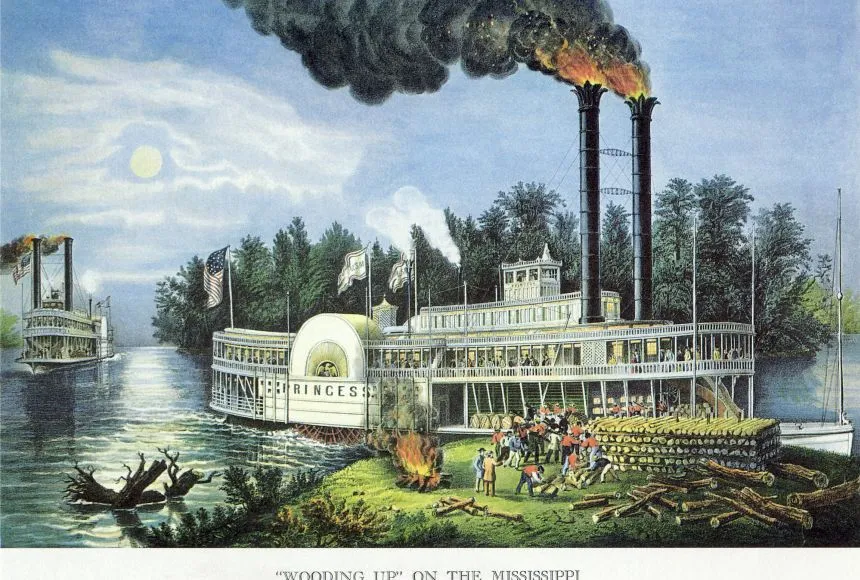The Myth of the Robber Barons
Steamships
Dr. Burt Folsom begins his lecture by talking about the growth trends of the industry in England vs. the United States in the 1800s. England was ahead in industries such as textile and railroads. This led many people to claim that the government needed to jump-start the economy of the United States. The invention of the Steamship as the “internet of its day” cut down ocean travel from two to three months to two weeks or less. This brought in the role of government and the power of entrepreneurship in the US. Edward Collins volunteered to receive a subsidy of 385,000 dollars and lead the way to surpass the British. At the time this was three percent of the national debt, a huge yearly amount. This was supported by the Constitution by delivering mail. Collins then asked for 3 million dollars to build the ships. Despite these huge costs, the incentive to compete and dominate the British made Congress accept the offer. He built four ships and put two of them in New York City. A new concept used with these ships is having a set time for leaving. Previously, ships, etc would simply leave when the ship was full. This was part of the new innovations being accomplished with government involvement. Collins then asked for another subsidy of 400,000 dollars for the next year which Congress granted him. Then again, the next year, he asked for 500,000 and 600,000 dollars the year after that.
Competition
Cornelius Vanderbilt was in the steamship business and became suspicious of this. He offered to do what Collins claimed and for half of the price. However, Congress took Collins's offer instead of the cheaper one. Perhaps this was to save face or for the purpose of familiarity. When Collins went out to port, there was another ship, “The Vanderbilt”. Both ships took off at the same time and Vanderbilt took the record for the fastest time at 11 days. By doing this, he found out that coal and fuel were used up more rapidly by dragging the ship through the ocean at top speed. This led to him going about one day slower per voyage than Collins in order to save money. He also cut passenger prices from one hundred plus dollars to thirty dollars and he sold food on his always full voyages. At the end of the year, Vanderbilt turned a profit. This was huge news to Congress since he made a profit without a subsidy. This made Collins ask for a larger subsidy because he was losing business. Despite this, Congress still granted Collin’s wish. He started to advertise being faster; the one thing he could outperform Vanderbilt in. Yet all of the sudden, Vanderbilt began competing with this aspect too. In his quest to be the fastest, Collins had a ship sink. This resulted in a fifty percent loss and an immediate request to Congress for another ship built costing a million dollars. Again, his request was granted and the rush to build this ship resulted in it being leaky from poor caulking. This resulted in him having to sell the ship and taking a loss of nine hundred and ninety thousand dollars. Once again, he requests another ship from Congress with the contribution of the ten thousand dollars he made from the previous ship sale. Finally, they had learned their lesson and rejected this request. It was time for Collin’s line of ships to die and it was time for a new beginning. Vanderbilt received his competition from companies in England. The eleven million dollars spent on steamship subsidies made up one-third of the United States' national debt. Vanderbilt then became the wealthiest person in US history and was the first American worth one hundred million dollars. His entrepreneurship in steamships and railroads led him to these accomplishments.
Railroad Subsidies
This subsidy mistake was repeated once again two years later. The Central Pacific and Union Pacific railroads were both given federal subsidies of sixteen thousand dollars a mile. The railroads were using dynamite to blow up each other’s tracks and when they were demanded to stop this, they paralleled each other. One man named James J Hill had the Vanderbilt spirit and figured out how to get past the mountains and built an unsubsidized railroad that didn’t go broke. The United States as a nation had to decide no more subsidies and success would be based on the accomplishments of the privately financed entrepreneurs. This led to world leadership by the time of the oil industry and John D Rockefeller. The key to great economic growth was now revealed.
